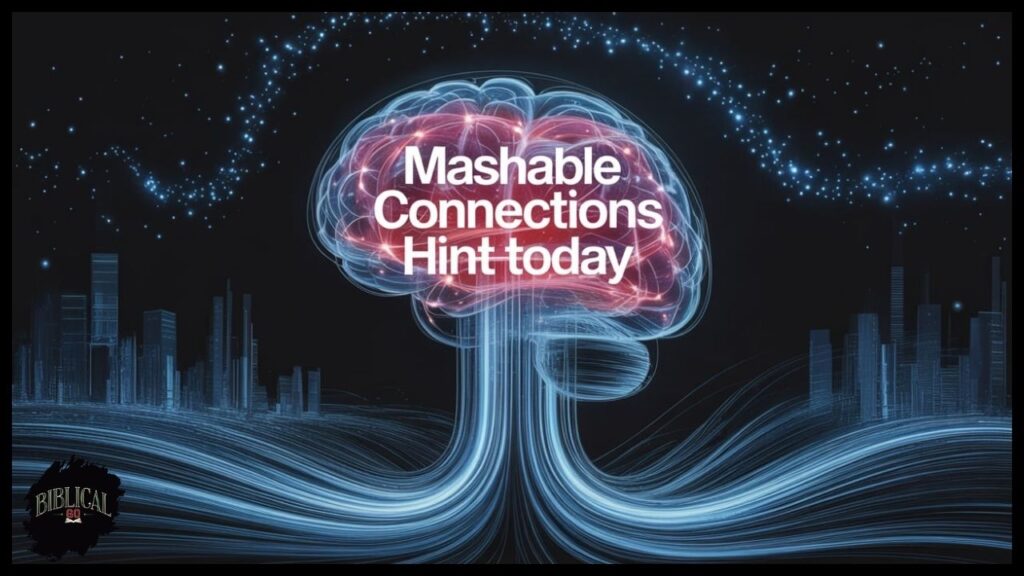Ready to crack today’s NYT Connections puzzle? You’ve landed in the right spot. Mashable connections hint today delivers the perfect balance of guidance without spoiling your solving experience.
This comprehensive guide breaks down today’s connections mashable puzzle while teaching you proven strategies that’ll transform you into a Connections master.
Whether you’re stuck on a tricky category or want to improve your puzzle-solving skills, we’ve got everything covered. Let’s dive into today’s NYT Connections challenge and unlock those satisfying “aha!” moments.
Understanding Today’s NYT Connections Puzzle Structure
NYT Connections presents sixteen words arranged in a 4×4 grid. Your mission? Group these words into four categories of four words each. Sounds simple, right? The genius lies in the complexity hiding beneath this apparent simplicity.
Each puzzle follows a consistent difficulty progression:
- Yellow Category: Easiest connections, usually straightforward themes
- Green Category: Moderate difficulty requiring some lateral thinking
- Blue Category: Intermediate challenge with potential misdirection
- Purple Category: Hardest group featuring complex wordplay or cultural references
Pattern recognition becomes your strongest ally here. The puzzle designer carefully plants red herring clues to mislead solvers. That’s where disambiguation strategies prove invaluable.
How Mashable Connections Hints Work
Mashable provides puzzle hints without crushing your solving joy. Their approach focuses on thematic clustering guidance rather than direct answers. You’ll get nudges about category themes, difficulty warnings, and strategic advice.
This method preserves the puzzle’s integrity while offering genuine help when you’re genuinely stuck. Mashable connections today maintains this delicate balance between guidance and discovery.
Today’s Puzzle Analysis: Breaking Down the Categories
Yellow Group: The Foundation Builder
Today’s yellow category typically features the most obvious connections. Look for:
- Literal word associations that share clear common ground
- Semantic similarity between terms
- Category inference based on shared functions or characteristics
Pro tip: Don’t overthink the yellow group. If four words seem obviously related, trust that instinct. The puzzle creator designs this category as your confidence builder.
Green Group: Where Things Get Interesting
The green category introduces lexical ambiguity. Words might connect through:
- Multisense words with shared secondary meanings
- Thematic categorization requiring cultural knowledge
- Synonym clustering that isn’t immediately obvious
Today’s connections mashable puzzle shows this perfectly. Words appearing unrelated on the surface often share deeper contextual bonds.
Blue Group: The Trickster Category
Blue categories excel at polysemy – single words carrying multiple meanings. Consider how “DIAMOND” could reference:
ContextMeaningCategory PotentialJewelryGemstonePrecious stonesBaseballInfield shapeSports termsGeometryRhombusShapesCardsSuit symbolCard game elements
This semantic ambiguity creates the puzzle’s most satisfying moments when connections suddenly click.
Purple Group: The Ultimate Challenge
Purple categories demand cognitive associations that stretch beyond obvious connections. Expect:
- Cultural references requiring specific knowledge
- Wordplay involving puns or linguistic tricks
- Abstract thematic links connecting seemingly unrelated concepts
Lateral thinking becomes essential here. The connections often exist in unexpected realms.
Proven Strategies for Mashable Connections Success
The Elimination Method
Start with certainties. Identify the most obvious group first, then work systematically through remaining words. This puzzle grouping technique prevents overwhelm and builds momentum.
Word grouping strategy in action:
- Scan for immediate connections
- Test potential groups mentally before committing
- Use elimination to narrow possibilities
- Save uncertain groups for last
Managing Red Herrings Effectively
Red herring detection separates good solvers from great ones. Common traps include:
- Surface-level similarities that don’t reflect true connections
- Partial matches where three words fit but the fourth doesn’t
- Baseball-themed distractions (BATTER, PITCHER, PLATE, INFIELD often appear as decoys)
Smart puzzle-solving strategies involve questioning your first instincts. If a connection seems too obvious, double-check for deeper alternatives.
The Four-Mistake Rule
You get exactly four wrong attempts. Use them strategically:
- Early testing: Try uncertain groups when you have mistakes to spare
- Process elimination: Wrong answers reveal correct groupings indirectly
- Pattern learning: Each mistake teaches puzzle structure
Daily puzzle challenge veterans know that strategic mistakes often lead to breakthrough moments.

Advanced Techniques for NYT Connections Mastery
Semantic Network Thinking
Successful solvers build semantic networks connecting words through multiple pathways. Consider how “PASTE” might relate to:
- Cooking context: Ingredient preparation (with DOUGH, BATTER, MIXTURE)
- Office supplies: Adhesive materials
- Computer commands: Copy/paste functions
This multisense word flexibility creates puzzle complexity and solving opportunities.
Thematic Pattern Recognition
NYT Games puzzles often feature recurring themes:
- Kitchen items and cooking terms
- Tableware and dining elements
- Climbable objects and outdoor activities
- Geometric shapes and mathematical concepts
Building familiarity with these patterns accelerates your puzzle logic development.
Cultural Reference Mastery
Purple categories frequently draw from:
- Pop culture references spanning decades
- Literature and historical connections
- Scientific terminology and concepts
- Sports knowledge across various disciplines
Today’s connections mashable might reference any of these domains, making broad knowledge invaluable.
Common Puzzle Categories and Examples
Cooking Concoctions Category
When you spot cooking-related words, consider these semantic entities:
- BATTER: Pancake mixture
- DOUGH: Bread foundation
- MIXTURE: Combined ingredients
- PASTE: Thick consistency blend
These cooking terms share the common thread of ingredient preparation requiring combination and consistency.
Dinner Party Table Items
Tableware categories often include:
- CANDLESTICK: Table decoration
- PITCHER: Beverage server
- PLACEMAT: Table protection
- PLATE: Food vessel
The connection lies in dining context rather than specific function.
Climbable Objects Analysis
Climbing-related words demonstrate thematic clustering:
- LADDER: Structured climbing tool
- MOUNTAIN: Natural climbing challenge
- ROPE: Climbing assistance equipment
- TREE: Climbable natural structure
The theme unifies through vertical movement possibilities.
Mashable’s Hint Philosophy Explained
Spoiler-Free Guidance Approach
Mashable maintains puzzle integrity through:
- Thematic hints without revealing specific words
- Difficulty assessments for category preparation
- Strategic guidance focusing on approach rather than answers
This method preserves the solving experience while providing genuine assistance.
When to Seek Additional Help
Sometimes nyt connections hints today mashable aren’t enough. Consider additional resources when:
- Purple categories seem completely opaque
- Multiple potential groupings appear equally valid
- Time pressure affects your thinking clarity
Reddit puzzle discussions and Game Rant answers offer community perspectives that can break mental blocks.
Daily Practice Benefits and Long-term Improvement
Cognitive Enhancement Through Regular Solving
Daily NYT puzzle help develops:
- Enhanced pattern recognition abilities
- Improved lateral thinking skills
- Stronger semantic associations
- Better disambiguation reflexes
These cognitive enhancers extend beyond puzzle-solving into real-world problem-solving scenarios.
Building Your Puzzle Archive Knowledge
Connections puzzle archive access helps you understand:
- Recurring theme patterns across puzzles
- Common misdirection techniques used by creators
- Difficulty progression within individual puzzles
- Cultural reference frequency and types
Puzzle designer Wyna Liu’s patterns become recognizable through consistent practice.
Community Engagement Benefits
NYT Connections community involvement offers:
- Alternative solving perspectives from diverse backgrounds
- Hint sharing without direct spoilers
- Strategy discussions for improvement
- Cultural knowledge expansion through group learning
Technical Game Mechanics and Interface Tips
Optimizing Your Solving Environment
Word association game tips for better focus:
- Choose consistent solving times for cognitive rhythm
- Minimize distractions during puzzle attempts
- Use the shuffle feature when patterns aren’t emerging
- Track your mistake usage strategically
Understanding Feedback Systems
The game provides immediate feedback through:
- Color-coded difficulty confirmation after successful groups
- Mistake tracking showing remaining attempts
- Category reveals confirming your reasoning accuracy
Advanced Disambiguation Strategies
Handling Polysemy Effectively
Multisense words require systematic approach:
- List all known meanings for ambiguous words
- Cross-reference meanings with other puzzle words
- Test connections across different semantic domains
- Prioritize based on puzzle difficulty expectations
Context Switching Techniques
Lexical ambiguity resolution involves:
- Domain jumping between different knowledge areas
- Meaning flexibility allowing multiple interpretations
- Pattern testing across various thematic possibilities
Today’s Specific Solving Insights
Current Puzzle Characteristics
NYT connections hints today mashable suggests today’s puzzle features:
- Moderate yellow category with clear thematic connections
- Challenging green group requiring cultural knowledge
- Tricky blue category with semantic ambiguity
- Complex purple group demanding abstract thinking
Strategic Approach Recommendations
For today’s connections mashable success:
- Start confident: Tackle obvious connections first
- Question assumptions: Don’t lock onto first interpretations
- Use mistakes wisely: Test uncertain groups early
- Think thematically: Consider broader categorical relationships
Puzzle Psychology and Mental Approaches
Overcoming Solving Blocks
When stuck, puzzle-solving skills include:
- Mental reset: Step away briefly for fresh perspective
- Assumption challenging: Question your initial interpretations
- Systematic testing: Work through possibilities methodically
- Community consultation: Seek hints without spoilers
Building Confidence Through Practice
Beginner tips for NYT Connections emphasize:
- Consistent practice for pattern familiarity
- Mistake analysis for learning acceleration
- Theme recognition development over time
- Strategy refinement through experience
The Future of Word Puzzle Solving
Technology Integration Potential
NLP and semantic processing technologies increasingly influence puzzle design and solving assistance. Thematic categorization algorithms help create more sophisticated challenges while disambiguation strategies improve hint quality.
Community Evolution
NYT Connections community continues expanding, bringing diverse perspectives that enrich solving experiences. Mashable connections and similar platforms adapt their puzzle hints approaches based on solver feedback and success rates.
Conclusion: Mastering Today’s Connections Challenge
Mashable connections hint today provides the perfect launching pad for puzzle success. Remember that NYT Connections puzzle mastery develops through consistent practice, strategic thinking, and willingness to embrace cognitive flexibility.
Today’s connections mashable puzzle offers another opportunity to strengthen your pattern recognition, semantic association, and logical reasoning abilities. Whether you solve it in minutes or need multiple hint consultations, each attempt builds your puzzle-solving toolkit.
The beauty of word grouping puzzles lies not just in finding correct answers, but in discovering the elegant connections that bind seemingly unrelated concepts. Mashable’s hint philosophy preserves this discovery joy while providing genuine assistance when needed.
Keep practicing, stay curious, and remember every NYT Connections puzzle is a mini-adventure in language, logic, and lateral thinking. Today’s puzzle awaits your solving prowess. Ready to crack those connections?
Frequently Asked Questions
How accurate are Mashable Connections Hint Today solutions?
Mashable Connections Hint Today provides highly accurate hints with a spoiler-free approach. They focus on thematic guidance rather than direct answers, maintaining puzzle integrity while offering genuine help when you’re stuck.
What time does Mashable Connections Hint Today get updated?
Mashable Connections Hint Today typically updates shortly after the new NYT puzzle releases at midnight ET. Their team works quickly to analyze patterns and provide strategic hints without spoiling the solving experience.
Can beginners use Mashable Connections Hint Today effectively?
Absolutely! Mashable Connections Hint Today caters to all skill levels. They provide difficulty warnings, strategic guidance, and gentle nudges that help beginners learn pattern recognition without overwhelming them with complex strategies.
Does Mashable Connections Hint Today reveal actual answers?
No, Mashable Connections Hint Today maintains a strict spoiler-free policy. They offer thematic clues, category difficulty assessments, and solving strategies while preserving the satisfaction of discovering connections yourself.
How does Mashable Connections Hint Today compare to other hint sources?
Mashable Connections Hint Today stands out for its balanced approach providing substantial help without killing the puzzle’s joy. Unlike direct answer sites, they focus on teaching recognition patterns and strategic thinking for long-term improvement.
Read more knowledgeable blogs on Biblical Go

Piper McMillan is a devoted writer and Bible enthusiast, offering insightful guides on Bible verses. Her blog provides practical interpretations and reflections, helping readers deepen their faith and understanding of Scripture through accessible and inspiring content.



